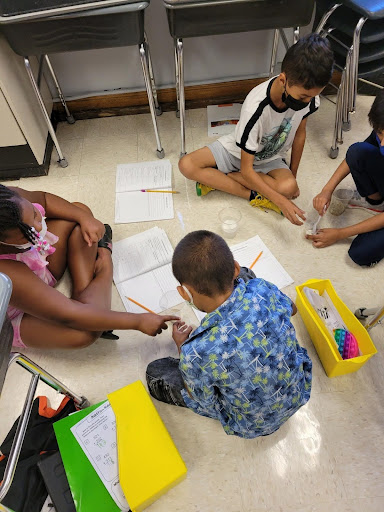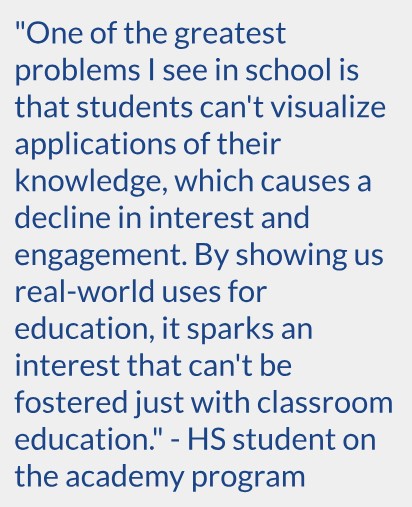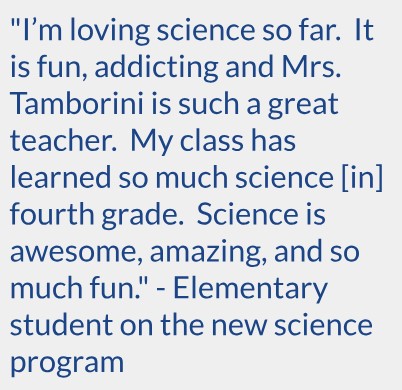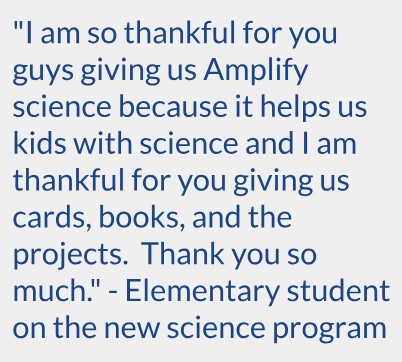"Engaging all students in using STEM to solve rigorous, relevant, real-life problems"
 The School District of Beloit is located in South Central Wisconsin, on the Illinois border. It had 5,165 students in September of 2022, with 32% white, 35.6% hispanic, 21.3% black, 10% two or more races, and 1% other racial groups. In 2021, Dr. Kevin Anderson had the privilege of interviewing several of their teachers and leaders, and the below profile is an amalgamation of their responses, edited for clarity and brevity.
The School District of Beloit is located in South Central Wisconsin, on the Illinois border. It had 5,165 students in September of 2022, with 32% white, 35.6% hispanic, 21.3% black, 10% two or more races, and 1% other racial groups. In 2021, Dr. Kevin Anderson had the privilege of interviewing several of their teachers and leaders, and the below profile is an amalgamation of their responses, edited for clarity and brevity.
School Profile Contents
What is our vision for this STEM work? What is our “why” for doing this work?
In our Beloit community, we saw an increasing need for better engaging our students in learning that would be meaningful and relevant to them. After ongoing conversations within our leadership teams, which includes administrators and a range of educators, we felt that a focus on STEM and STEAM would be an effective way to do that. Our Instructional Coordinator for STEAM, in particular, helped us in getting a new science curriculum off the ground.
Our vision is, “Engaging all students in using STEM to solve rigorous, relevant, real-life problems,” with the following Core Values:
- Support access and equity for all learners;

- Use standard-aligned curriculum;
- Connect to problems in the real-world;
- Develop and use authentic assessment structures;
- Be accountable for student success;
- Maintain a growth mindset for teachers, learners, and administrators;
- Create the conditions for joy in both teaching and learning.
We collaboratively built the vision and values to emphasize a plan for engaging, relatable, and applicable problems for students, while cultivating a love for learning. The value of joy, for both students and staff, particularly resonates with us.
To support coherence with other initiatives in our district, we are in the process of linking this STEM work to the School District of Beloit’s “North Star,” our “Portrait of a Graduate.”
While we are largely STEM-focused now, we are building toward a STEAM focus, seeing the arts integration as another key way to engage students. Students need to understand how to use these subjects together in the real world, and see that their knowledge has a purpose, which further underscores our priority of breaking down disciplinary silos.
In grades 4-8, STEM work has started with a new science program that integrates science and engineering. In particular these materials ask students to take on the role of a scientist or engineer as they explore phenomena, building up their STEM identities. At grades four and five that includes Project Lead the Way materials. Project Lead the Way is a nationally recognized problem-based engineering and technical education curriculum.
Our high school implemented an academy approach as part of breaking down silos. As noted on our website, “A college and career academy is a personalized small learning community within the high school, involving a cohort of students and a team of teachers for a two through four year span. Academies provide real-world experiences with local businesses and professionals, linking schoolwork and the workplace. Academy classes include core academic courses and career-technical courses.” It has helped to have a staff member whose sole job is to lead, coordinate, and market this academy effort. Momentum and positive development is because of her work.
Who made the decision to emphasize STEM?
Supporting and developing STEM has been an ongoing and collaborative decision with a team mentality. Our district and school leaders want to find ways to engage all students in meaningful problem solving that will better prepare them for life beyond school (and improve learning within school). No one person made this decision; our leaders and educators are collaboratively excited about it, and we all feel a responsibility for improving experiences for kids.
We want sustainability in our efforts. We have a new superintendent, and we will be developing a new strategic plan. We wonder about how STEM/STEAM will fit into the strategic plan, but we feel confident that these important efforts will continue.
Where is STEM happening? What do school and schedule structures look like to make it work?
There are several aspects of our schedules and procedures that have shifted to make STEM happen.
We changed the schedule in grades K-3 to create dedicated science time. Having this dedicated science time now through K-5 has worked wonders for our youngest learners in particular. It is impressive, for example, to see them using the engineering design cycle. We had very excited 1st graders making the best devices possible to protect an egg in an egg drop project.
In grades 4-8, teachers are more likely to specialize in subject areas. They teach multiple science classes throughout the day to decrease the number of preps across subjects and increase expertise.
Changing the elementary report card for science has also had an impact. A group of teachers from each grade, coaches, and the STEM Coordinator gathered together to modify report cards to better connect to the science practices, engineering, and each science discipline. More STEM projects are happening now to provide data related to these reporting categories.
It has also been useful to have updated technology. All students have Chromebooks, with K-2 students’ devices having a flip-screen touch pad to not rely on typing. Science simulations, curriculum-based assessments, and other learning programs have been much easier.
Additionally, students have library media center time twice a week. One day focuses on traditional library media use and check-out, but the other day is engagement in a Maker Space with topics set up by term and connected to the standards at each grade.
Considering other subjects, we adopted new K-5 ELA materials. We have specifically mapped out where they have overlap with science standards by content topics, and they will be connecting learning across subjects. That now happens in about one unit per grade level. Our leaders emphasize, however, that reading about science does not equal doing science.
Further, having new state math standards in 2021 worked out well for us in terms of timing as it coincided with program work we were in the process of doing. We have been working to anchor our math curriculum in priority standards at each grade level. This work includes building in mathematics practices more intentionally into instruction. Especially in secondary learning, mathematics has historically been more lecture based, so the emphasis on practices is an important focus. We are in the process of reviewing high quality, equity focused math resources to match our intended learning and instructional goals. While there are overlaps in practices across STEM subjects, those connections are not yet as woven together as they will be. Our past focus on fidelity to materials and strict adherence to a pacing schedule has been relaxed, which is a cultural shift for educators. We want to lean into innovative instruction and our focus on math practices to support all learners.
To help drive a focus on practices across subjects, we have been moving to incorporate more performance-based tasks and real-world connections. In particular, we’re drafting benchmark assessments in math and science. For example, science educators in grades 4-8 wrote benchmark assessments based on the new curriculum. The assessments have the three dimensions of the standards explicitly called out, which in the long term will help students progress more clearly in relation to each dimension. Math benchmark assessments are similarly tagged to standards, to evaluate and reflect on progress more consistently and coherently. Having strong instructional coaches has especially helped with this benchmark assessment work and the other transitions we are making in the programs.
How is equity centered in this work?
As noted in our vision, “all” means all students. We want all students to have access to great instruction. Equity further means equal access to all opportunities and providing what students need to succeed. Meaningful student connections to each other, to staff, and to the world outside the school buildings are key aspects of equity. We want families to also understand the opportunities for and learning of their students.
Our leadership sees it as critical to figure out how to remove barriers and open up access. Students have a lot of opportunities at the high school, but it’s more than access; we have to make sure students are getting into these programs. Structures, and supports have to be in place to create a more equitable system. For example, we want the makeup of higher level classes to match demographics of our schools because we have created systems that allow students to build their STEM identities throughout their school experience with us.
How are community and student voices involved?
Building trust of teachers, community, and families has been an ongoing effort, and we feel like we’re making progress.
For example, we worked with students to determine which science curriculum to adopt, and we conducted student surveys to see how that program is going. Hundreds of students have shared their opinions and reflections, with many volunteering how much they’re enjoying the new science program.
At the high school level, the business community and local manufacturing firms are providing input related to their hiring and skills needs. Our Academy Coach is steering a lot of that work. Specifically, we are backwards mapping the workplace needs to build learning across each grade, with clear math, science, and Project Lead the Way pathways. We carefully reflect on changes needed to get to those community-supported endpoints we have. We are also contracting with CareerTek, an independent organization, to examine and refine our student curriculum pathways towards careers.
How are partnerships supporting this work?
 One of our partnerships is with Blackhawk Technical College. Students can take articulated classes at the high school and classes directly at Blackhawk. The Collegiate Academy at the high school particularly builds on this connection. Blackhawk staff support students and teachers in understanding higher education options.
One of our partnerships is with Blackhawk Technical College. Students can take articulated classes at the high school and classes directly at Blackhawk. The Collegiate Academy at the high school particularly builds on this connection. Blackhawk staff support students and teachers in understanding higher education options.
 Another partnership is with UW-Madison to increase diversity in STEM fields -- the GLOBE project. With funding from the National Science Foundation, this project “will bring together educational and environmental leaders throughout Beloit with faculty/staff from the University of Wisconsin- Madison Nelson Institute. Through trainings, mentorships, hands-on experiences, and more, the partnership is set to increase student interest in STEM, improve achievement gaps, and increase diversity within STEM degrees and careers.” Scientists will be coming into grades 6-12 classrooms to support building their identity. The Welty Environmental Center is also involved, supporting science inquiry at all levels and offering internships to high school students where they lead grades 1-5 field trips with clear standards connections. Beloit College is another partner on the grant to support teacher development and fostering college and career pathways for students.
Another partnership is with UW-Madison to increase diversity in STEM fields -- the GLOBE project. With funding from the National Science Foundation, this project “will bring together educational and environmental leaders throughout Beloit with faculty/staff from the University of Wisconsin- Madison Nelson Institute. Through trainings, mentorships, hands-on experiences, and more, the partnership is set to increase student interest in STEM, improve achievement gaps, and increase diversity within STEM degrees and careers.” Scientists will be coming into grades 6-12 classrooms to support building their identity. The Welty Environmental Center is also involved, supporting science inquiry at all levels and offering internships to high school students where they lead grades 1-5 field trips with clear standards connections. Beloit College is another partner on the grant to support teacher development and fostering college and career pathways for students.
What does professional learning look like?
An important goal is having sustainable professional development (PD) plans for math and science that involve high school educators, grants, partnerships, regional colleges, etc. in an ongoing way. We particularly want to build educator comfort and confidence in effective STEM instruction. One aspect of building comfort and buy-in is integrating literacy into STEM learning and PD.
The high school teachers offered to help elementary teachers, particularly in science, where they typically have a generalist background. Teaming allows for a strong and more sustainable way to develop some expertise among teachers.
Further, instructional coaches support our teacher teams. The coaches have helped teachers make connections to the math, science and engineering practices -- ideas such as supporting arguments with evidence that translate across subject areas. The coaches help teachers continue to grow in their instructional practice.
Like most districts, time is a huge challenge. How can you teach all subjects and support students with social-emotional learning and other needs? Teachers want to do a great job and people are excited about math and science, but time constraints to make the learning meaningful is a significant constraint. We hope to evolve our schedules and systems to maximize time for instruction, as well as teacher collaboration and PD.
Having the materials we need can be a challenge, but when we have them, we want to make sure they get used! We have a library room full of old materials - some kits that are up to 25 years old - which we have been replacing with higher quality instructional materials. Teachers need the time and professional development to make sure they can use science material in their classrooms. STEAM and science materials also require an ongoing replenishment, which is a long-term budget commitment that we are working out.
Finally, questions about professional learning and visioning continue. Have we done enough to help teachers and administrators understand the direction we are headed? Do our teachers really understand the difference between STEAM And STEM? Can teachers fully see how they connect to the implementation plan and are they bought into it?
How will the STEM program be evaluated?
As part of the development of the STEM program in general, evaluation is a work in progress. Program evaluations are being drafted. We identified priority standards and compelling questions in mathematics as the basis of these evaluations. In science, the progress will be based on the science and engineering practices. As we clearly define our metrics, we will be building SMART goals to be sure we have a clear timeline for checking in our progress.
We want to focus on objective indicators, so we realize that measuring joy, one of our goals, might be tricky. We are exploring survey options now that can provide insights into student attitudes and engagement as proxies for this objective.
Thinking of reflection on our work, we thought the DPI STEM Self-Reflection Tool helped us think about our programs in new ways.
 As we reviewed our STEM program in relation to this DPI tool, we found that we really needed a column before “Initial” on the rubric. Because our work is now getting moving, some of it did not meet the “initial” category description, but we still wanted to note what it is. We appreciate that DPI STEM leaders, based on this feedback, revised the reflection tool, and made an open-ended, left-side column for describing early work.
As we reviewed our STEM program in relation to this DPI tool, we found that we really needed a column before “Initial” on the rubric. Because our work is now getting moving, some of it did not meet the “initial” category description, but we still wanted to note what it is. We appreciate that DPI STEM leaders, based on this feedback, revised the reflection tool, and made an open-ended, left-side column for describing early work.
We felt this tool prompted and helped anchor further conversations and planning for what’s next. For example, we saw a need to not just do “STEM” or “STEAM,” but to make sure we are doing it right and that it is part of a unified and coherent body of work for students. Also, in discussion of this tool we considered the balance of guided versus self-directed learning, realizing that more self-directed learning opportunities would be important in our curriculum shifts. This type of work is always a work in progress.